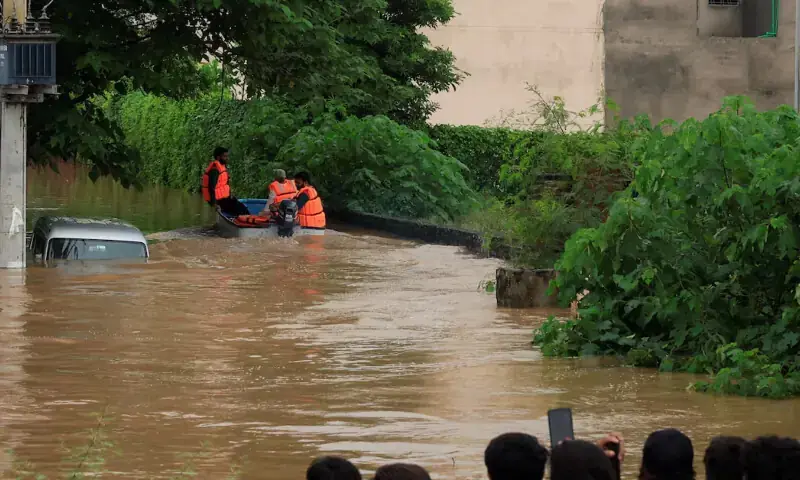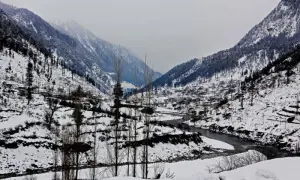Multan and Muzaffargarh brace for next flood wave
Floods in the three major rivers of Punjab – Chenab, Ravi and Sutlej – continued to wreak havoc, affecting more than 1.5 million people and causing widespread devastation.
More than 248,000 people lost their homes, while around 280 villages have been submerged in floodwaters.
According to the Provincial Disaster Management Authority (PDMA), 28 people have died so far due to the floods in the province.
However, timely rescue operations have prevented further loss of life. Dozens of people are still missing.
A major flood wave is expected to reach Multan by Saturday evening, where the authorities have launched efforts to evacuate over 300,000 people.
Floods wreak havoc in Punjab; 20 dead, 280 villages submerged
Water level declines
Meanwhile, the water level in the Ravi River continued to decline. At Shahdara, the flow has decreased from 157,000 cusecs to 138,000 cusecs.
At Jassar, the flood wave has reduced from 80,000 to 78,300 cusecs. However, at Head Balloki, the water level in the Ravi River is continuously rising, with a flood wave of 194,800 cusecs currently passing through.
According to the Flood Forecasting Division (FFD), further improvement in the situation is expected in the coming hours.
Last night, 17 people trapped in floodwaters near Manga Mandi and Saggian Bridge were safely rescued and moved to secure locations.
In Chishtian, the water flow in the Sutlej River has risen to dangerous levels. Due to the strong current, two major embankments have collapsed — Dolah Akoka and Bhini Machhian Wala.
Thousands of acres of cultivated farmland are now underwater. There is also a risk of flooding in other areas, including Dolah Bhadera.
At Head Sulaimanki, both the inflow and outflow of water have been recorded at 138,000 cusecs.
Widespread destruction
Meanwhile, new stories of destruction have emerged from the three major rivers of Punjab — Chenab, Ravi, and Sutlej.
Due to flooding, a total of 1.5 million people have been affected, out of which 248,000 have been rendered homeless.
In Pakpattan, a high-level flood wave caused widespread destruction, breaking several protective embankments and submerging many settlements.
The submersion of a major road has cut off access to several communities, increasing the difficulties for local residents.
Meanwhile, dozens of villages in Head Marala and Sialkot have also been submerged, paralysing daily life and leading to outbreaks of disease among the affected population.
Efforts to protect Kasur
According to Irfan Ali Kathia, Director General of PDMA Punjab, following a dam breach in India, Kasur experienced the highest level of the Sutlej River since 1955.
The current challenge is to protect Kasur to avoid catastrophe, he added.
The intensity of the flood in the Chenab River has not subsided, and it is moving towards south Punjab.
A ferocious flow of more than 8.5 million cusecs has entered Jhang, inundating many villages along the river and submerging the Jhang-Chiniot road.
Over 100,000 people have been evacuated from 140 villages near Jhang.
As the floodwaters move toward the city, three breaches were deliberately made in the 120-year-old Rewas Bridge — built in 1905 — using explosives to divert the flow.
According to the Jhang deputy commissioner, the breaches will direct the water flow into nearby villages, thereby reducing pressure on the Trimmu Headworks.
However, a 5-kilometre stretch of railway track is also expected to be affected by the breach, he added.
150 villages submerged
Before reaching Jhang, the raging flood wave caused devastation in the villages of Hafizabad and then Chiniot. Around 150 villages have been submerged at Qadirabad in Hafizabad.
At Head Qadirabad, increased water flow has submerged 75 settlements. Near Chiniot, the Sargodha-Jhang road has gone underwater, while 400 people have been rescued from the affected villages.
According to officials, the flood wave will head toward Multan and Muzaffargarh after Jhang.
The next 24 to 48 hours are critical for both cities. To protect the urban population of Multan, authorities have decided to make a controlled breach at Head Mohammad Wala.
There is a severe shortage of food in the flood-affected areas, and cases of skin diseases have surged. Displaced people are now forced to take shelter along the motorway.
Thousands of flood victims are being relocated to safer places via boats by the Pakistan Army and local administration.
India releases water into Jhelum River
India continues to release more water, and after the Sutlej, Ravi, and Chenab, water has now been released into the Jhelum River too.
According to the State Disaster Management Authority (SDMA) of Azad Kashmir, India has released the water, and a wave of 19,690 cusecs has entered Azad Kashmir from the Chakothi point at the Line of Control.
According to SDMA, the water level at Chakothi in the Jhelum River is continuously rising. The areas from Muzaffarabad and Hattian Bala down to Mangla may experience a rise in water levels.
Due to the flooding risk, SDMA has issued an alert and instructed residents living near the river to move to safer locations.
For the latest news, follow us on Twitter @Aaj_Urdu. We are also on Facebook, Instagram and YouTube.
















Comments are closed on this story.